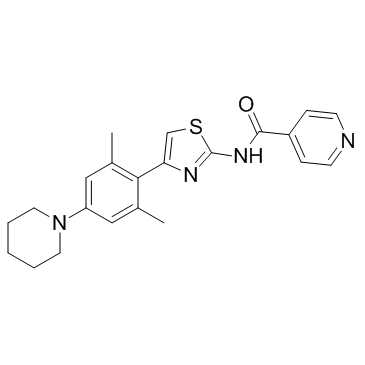INH154 |
| Catalog No.GC34150 |
INH154 is a highly potent inhibitor for Nek2 and Hec1 binding (INH), with IC50s of 200 nM and 120 nM for INH in Hela and MB468 cells.
Products are for research use only. Not for human use. We do not sell to patients.

Cas No.: 1587705-63-2
Sample solution is provided at 25 µL, 10mM.
INH154 is a highly potent inhibitor for Nek2 and Hec1 binding (INH), with IC50s of 200 nM and 120 nM for INH in Hela and MB468 cells.
INH154 is highly potent in treating breast tumors with co-elevated expression of Hec1 and Nek2. INH154 is the most potent inhibitor of tumor cell growth. The IC50 values of INH154 in HeLa and MDA-MB-468 cancer cells are 0.20 and 0.12 μM, respectively. INH154 also suppresses the growth of leukemia, osteosarcoma, and glioblastoma cells[1].
Tumor growth rates in mice treated with INH154 are evidently slower than those in control animals in a dose-dependent manner. In agreement with the tumor-growth data, the tumor proliferation index, determined by measuring BrdU staining, is clearly reduced in residual tumors treated with INH154 in comparison with vehicle alone. The expression levels of Nek2 and Hec1 S165 phosphorylation are also substantially reduced in INH154-treated tumors than in vehicle-treated tumors. On the other hand, mice body weights are measured during the 6.5 weeks treatment period and show little difference among treated and control groups. In addition, the toxicity of INHs by treating normal BALB/c ByJNarl mice with high dosage of INH154 (20 mg/kg) shows no significant difference of body weights, blood chemistry, and complete blood count (CBC) analysis among these groups of animals[1].
[1]. Hu CM, et al. Novel small molecules disrupting Hec1/Nek2 interaction ablate tumor progression by triggering Nek2 degradation through a death-trap mechanism. Oncogene. 2015 Mar 5;34(10):1220-30.
Average Rating: 5 (Based on Reviews and 14 reference(s) in Google Scholar.)
GLPBIO products are for RESEARCH USE ONLY. Please make sure your review or question is research based.
Required fields are marked with *




















